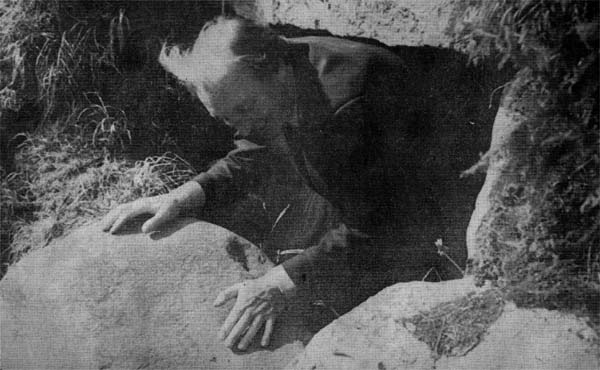Haughey Returns from the Tomb
An article by Olivia O' Leary printed in The Irish Times - 27 August 1980
The Taoiseach, Mr Haughey, leaving one of the tombs at Knowth | Photo by Eddie Kelly
I'm guarding the tomb, said Brendán O'Riordáin, director of the National Museum, perched on the stone mouth of the burial mound into which the Taoiseach had disappeared. Even without the angles, Mr Haughey got back out again, exclaiming at the beauty of the 5,000-year-old Knowth site. Asked if it would not be a grand place to build civic offices, he grinned. On this sunny August day there would be no clash between the Sate and archaeology.
The excavation at Knowth have been going on since 1962 and Professor George Eogan is now ready to start work on the eastern tomb of the great central mound which with its two chambered tombs, is described as the most impressive late stone age monument in Western Europe. The western tomb had already been excavated. The bigger eastern tomb has a 100-foot long passage leading to a cruciform chamber with a 20-foot high roof. The great mound over it is made up of a cairn surrounded by layers of earth and retained by a ring of big kerbstones, which like many stones in the tombs are decorated.
As Professor Eogan explained to the Taoiseach on his visit yesterday, the size of the mound indicates the prosperity of the farming community in the Boyne valley area at the time. Only a wealthy community could have released the number of workers and engineering and architectural specialists needed to erect the tomb, and could have afforded to denude acres of grassland of the sods needed to make the earthen layers.
Reduced Budget
How long will it take to excavate the eastern tomb? About 10,000 years teased Mr Haughey. Professor Eogan though five years would be enough. He is working on a budget of £27,000 this year not as big as the £43,000 granted some years ago, but then the national allocation for excavation has been cut. The State has recently acquired additional land around the site to ensure its preservation and make excavation easier. It is not yet clear whether there is any particular significance to the whorl and line designs on the stones, except that vertical lines on large stones have so far indicated tomb entrances.After stone age pottery, baked in the sun, there are distinctive vessel of the beaker folk (about 2,000 BC), the Celts with their bits of Roman pottery, perhaps looted, and their bronze instruments, pins, handles and an ear pick for taking out wax. In the eighth to 11th centuries the site was the residence of the kings of North Brega. Bronze keys and a beard trimmer from this period were found, as were bracelets of jet and combs with which, said Professor Eogan, the women combed their golden hair. "Were they always the same?" murmured Mr. Haughey. He tramped the site, ignoring warnings that the ground was uneven, "Remember I'm an island man." he said and slithered down a slippery slope to meet the oldest worker on the site. "I suppose you knew the builder, said he.
Back behind him the local Garda Superintendent who wondered why they didn't build the grave entrances bigger "so a man could stand up when he went in," was surveying an exposed passage grave. "Why didn't we find papers here," he demanded of Professor Frank Mitchell of Trinity, "Why didn't we come across Dead Sea Scrolls?" Paper would have disintegrated in our environment, he was told. He accepted the point reluctantly. You don't succeed in the Garda force without developing a firm belief in the indispensability of documentary evidence.
Boyne Valley Private Day Tour
 Immerse yourself in the rich heritage and culture of the Boyne Valley with our full-day private tours.
Visit Newgrange World Heritage site, explore the Hill of Slane, where Saint Patrick famously lit the Paschal fire.
Discover the Hill of Tara, the ancient seat of power for the High Kings of Ireland.
Book Now
Immerse yourself in the rich heritage and culture of the Boyne Valley with our full-day private tours.
Visit Newgrange World Heritage site, explore the Hill of Slane, where Saint Patrick famously lit the Paschal fire.
Discover the Hill of Tara, the ancient seat of power for the High Kings of Ireland.
Book Now
Home
| Visitor Centre
| Tours
| Winter Solstice
| Solstice Lottery
| Images
| Local Area
| News
| Knowth
| Dowth
| Articles
| Art
| Books
| Directions
| Accommodation
| Contact

